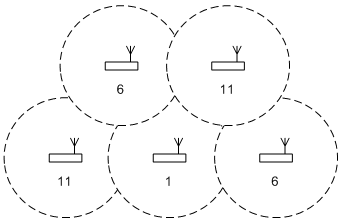
| Standard | Top speed (Mbps) | Number of speeds | Number of non-overlapping channels | Maximum legal free-space distance (ft) | Frequency range |
|---|---|---|---|---|---|
| 802.11a | 54 (30 effective) | 8 | 12 | 200 | 5 gHz (5.170-5.805) |
| 802.11b | 11 (6 effective) | 4 | 3 | 300 | 2.4 Hz (2.412-2.462) |
| 802.11g | 54 (30 effective) | 10 | 3 | 300 | 2.4 Hz (2.412-2.462) |
Table explanation:
There are currently three WiFi transmission standards, IEEE 802.11a, b and g. IEEE 802.11n was recently ratified, and will eventually replace these.
Top speeds are 11 or 54 Mbps, but with protocol overhead the effective speeds will be around half that.
If the signal is too weak to transmit reliably at top speed, the radios automatically slow down, increasing reliability.
Like car radios and TV sets, broadcasts are on different channels to avoid interference. 802.11 b and g have only 3 non-overlapping channels:

To avoid interference, the radio power, and therefore transmission distances are short. The power levels are set by the FCC. Much longer links can be achieved with specialized antennae and amplifiers. Note that the distance is lower for higher frequency transmission.
The frequency ranges are referred to as 2.4ghz and 5ghz, and the exact ranges are shown in parenthesis.
IEEE 802.11n has been agreed upon and standard products are expected later this year. Speeds will be around 300 Mbps (100 effective) and distances increased. 802.11n achieve this improvement by using multiple antennas and different modulation schemes. Second generation 802.11n equipment is expected to be nearly twice as fast.